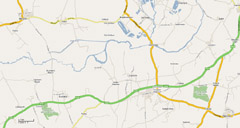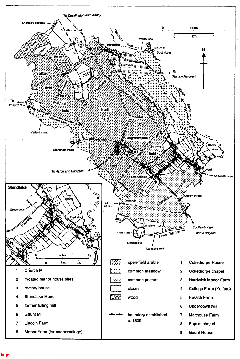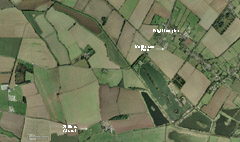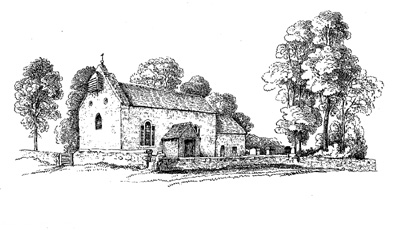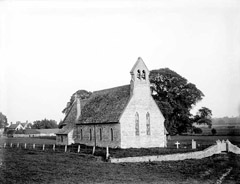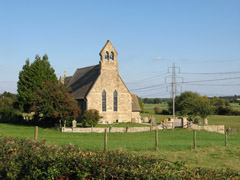

Return to Other Settler Familes List
Brown Family Page Pre-emigration generation A >> 1, 2, 3, 4, 5, 6, 7, 8, 9, 10, 11,
12, 13, 14, 15, 16, 17, 18, 19, 20, 21, 22, 23, 24, 25, 26, 27, 28, 29, 30, 31, 32, 33, 34,
35, 36, 37, 38, 39, 40, 41, 42, 43, 44, 45, 46, 47, 48, 49, 50, 51, 52, 53, 54, Index
Parents of George Brown (Apr 1836 - 23 Dec 1898)
Pre-emigrant Generation
*********************************************************************************************1A. Thomas Brown. Son of Thomas Brown and Jane. born ca 1800, Southmoor, Berkshire ca 1800 (from 1851 Census). Christened 1800. Died after 1851.
He married Sophia Hissey of Southmoor at Longworth on 20 July 1820 (North Berks Marriage Index - Husbands). Sophia was the daughter of John Hissey and Mary Dewe. Sophia was baptized on 25 June 1797 at Longworth Parish Church, Berkshire (Longworth Berks. Parish Registers Baptisms and Marriages, p. 59).
Thomas and Sophia had at least 11 children. Most christened at Shifford Chapel (Goadby, 1970), a structure that was razed in 1861 due to structural problems and then rebuilt in 1861-1862 (see illustrations below). In recognition of their mother Sophia's maiden name their seventh child John Hissey Brown was named for Sophia's father John Hissey. Thomas was one of a long line Thomas's and thus their eldest son was named Thomas as well.
Beginning with the birth of their oldest child Thomas the residence of Thomas and Sophia is listed as Brighthampton with Thomas's profession listed as farmer. The Browns had long been a prominent Yeoman family in the area and in addition to being substantial farmers were also malters. Thomas Brown, at least initially, followed this tradition as they lived on Malthouse Farm, which had been in their family since an an earlier George Brown (d. 1761) had received copyhold for the property and built a malthouse in 1740 (Baggs et al., 1996).
Medium sized pop up image
900 X 479, 72 dpi, 119 kFull sized pop up image
1387 X 738, 72 dpi, 469 kMap of communities in northern Berkshire and just across the Thames in southern Oxfordshire where the families of Thomas Brown and wife Sophia Shifford lived for several generations. Source: Google Maps.
Medium sized pop up image
900 X 523, 72 dpi, 230 kFull sized pop up image
1330 X 773, 72 dpi, 855 kAirphoto at same scale as the map to left of communities in northern Berkshire and just across the Thames in southern Oxfordshire where the families of Thomas Brown and wife Sophia Shifford lived for several generations. Source: Google Maps.
Medium sized pop up image
900 X 1348, 72 dpi, 115 kAn 1850 map of Brighthampton showing localities of various farms in the community including Malthouse Farm where Thomas Brown and wife Sophia Hissey lived.
Source: Bagg et al. (1996)
http://www.british-history.ac.uk/Medium sized pop up image
900 X 532, 72 dpi, 181 kFull sized pop up image
1314 X 776, 72 dpi, 739 kAir photo showing relative position of Malthouse Farm and the Shifford Church (see images below) where all of the children of Thomas Brown and Sophia Hissey were christened as well as the burial place of several generationsof the Brown family. Source: Google Maps.
Medium sized pop up image
900 X 481, 72 dpi, 196 kFull sized pop up image
1387 X 742, 72 dpi, 329 kAir photo showing relative position of Malthouse farm within Brighthampton. Source: Google Maps.
In the 1841 census the Thomas Brown residence is identified as Bampton Hundred, Brighthampton. This is not a specific reference to their farm but to an ancient division of land covering some 48,500 acres on the west side of Oxfordshire, the eastern boundary of which ran through the western part of Brighthampton. Further confirmation that Thomas was a landowner at Malthouse Farm is provided in the 1851 census where he is listed as a "Landed Proprietor". In the Oxfordshire context this generally meant that not only did one own land but indicated that at least part of the property was rented out to earn an income. It is unknown at present though as to how large the land holdings of Thomas Brown were. In the time of an earlier Thomas Brown (d. 1764) the family also owned Manor Farm in adjacent Standlake. It is not known whether this property or others were still in the family.
For unknown reasons Thomas Brown let the malthouse at Malthouse Farm fall into disrepair and it had partly fallen down before 1855 (Baggs et al., 1996) and was demolished completely by 1857 (Ackerman, 1857, 1860) resulting in the discovery of an ancient Anglo-Saxon burial ground under the foundations (see below).
Sophia Hissey died on 9 Feb 1843 and was buried in the Shifford Parish Church graveyard on 24 Feb 1843.
From the list of Memorials in Shifford Church & Churchyard (from Giles's History of Bampton dated 1847) as recompiled in Goadby (1970, p. 55). 1843 was not a good year for the family as their eldest son Thomas also died that year on 1 May 1843 at the age of 21.
From the list of Memorials in Shifford Church & Churchyard (from Giles’s History of Bampton dated 1847) as recompiled in Goadby (1994), p. 55:
BROWNE, Sophia wife of Thomas of Brighthampton, d. 19 Feb 1843, age 45.
They had the following Children (see supplemental information below for baptismal records):
2A i Thomas Brown
3A ii Sophia Brown
4A iii Alfred Brown
5A iv Louisa Brown
6A v Henry Brown
7A vi Sarah Ann Brown
8Avii John Hissey Brown
9A viii Stephen Brown
10A (1) ix George Walter Brown
11A ix Charles Brown.
12A x Sarah Ann BrownThomas Brown and Sophia Hissey chidren baptismal records
2A i: Thomas Brown
Baptized 9 Sep 1821 at Shifford Parish Church (Church of England), Oxfordshire. Son of Thomas (farmer) and Sophia Brown of Brighthampton, p. 7. d. 1 May, 1843, aged 21.
3A ii: Sophia Brown
Baptized 26 Dec 1823 at Shifford Parish Church (Church of England), Oxfordshire. Son of Thomas (farmer) and Sophia Brown of Brighthampton, p. 7.
4A iii: Alfred Brown
Baptized 9 Jul 1826 at Shifford Parish Church (Church of England), Oxfordshire. Son of Thomas (farmer) and Sophia Brown of Brighthampton, p. 8.
5A iv: Louisa Brown
Baptized 20 Jul 1828 at Shifford Parish Church (Church of England), Oxfordshire. Son of Thomas (farmer) and Sophia Brown of Brighthampton, p. 8. buried, 9 Nov 1848, aged 22.
6A v: Henry Brown
b. ca 1830 (from 1841 census).
7A vi: Sarah Ann Brown
Baptized 30 Nov 1831 at Shifford Parish Church (Church of England), Oxfordshire. Son of Thomas (farmer) and Sophia Brown of Brighthampton, p. 8. d. 2 Oct 1835, aged 4.
8A vii: John Hissey Brown
Baptized 26 Apr 1833 at Shifford Parish Church (Church of England), Oxfordshire. Son of Thomas (farmer) and Sophia Brown of Brighthampton. Shifford Parish Register p. 8.
9A viii Stephen Brown
Baptized 5 Apr 1835 at Shifford Parish Church (Church of England), Oxfordshire. Son of Thomas (farmer) and Sophia Brown of Brighthampton. Shifford Parish Register p. 9.10A (1) ix: George Walter Brown
Baptized 24 Mar 1837 at Shifford Parish Church (Church of England), Oxfordshire. Son of Thomas (farmer) and Sophia Brown of Brighthampton. Shifford Parish Register p. 9.
11A ix Charles Brown
Baptized 8 Mar 1839 at Shifford Parish Church (Church of England), Oxfordshire. Son of Thomas (farmer) and Sophia Brown of Brighthampton. Shifford Parish Register p. 9.
12A x Sarah Ann Brown
b. ca 1842 (from 1851 census)
Shifford Church
Medium sized pop up image
900 X 517, 72 dpi, 281 k
Sketch of Shifford Chapel, circa 1850. A chapel has existed on this site since ca AD 1230. The chapel was periodically modified although the position of the church on the flood plain of the Thames contributed to the deterioration of the structure. This difficulty was noted in the early 18th century when it was stipulated that prayers and a sermon would occur at Shifford 'when the weather and floods permit'. By the late 18th century the structure was periodically left derelict. By 1787 repairs had been made and by the early 19th century ~30 persons attended services regularly, a number which increased to ~50 by 1851. This was the state of affairs when Thomas Brown and Sophia Hissey attended services here with their children, most of whom were christened here. Due to its age and periodic flood damage the building was in need of almost constant repair. It was decided that it would be best to raze the structure and rebuild on the same foundation. Following demolition of the old chapel in 1861 the current St. Mary's Church illustrated below was immediately built in 1861-1862 and still is in occassional use. Source: History of the County of Oxford, vol 13. For more detailed information see:
http://www.british-history.ac.uk/report.aspx?compid=15957
Medium sized pop up image
700 X 537, 72 dpi, 183 k
Medium sized pop up image
700 X 525, 72 dpi, 162 kFull sized pop up image (4X6 crop for printing)
3648 X 2736, 180 dpi, 4649 k
References:
Akerman, J.Y. 1857 "Researches in a Cemetery of the Anglo-Saxon Period at Brighthampton, Oxon.", Archaeologia 37, 391-398.
Akerman, J.Y. 1860 "A Cemetery of the Anglo-Saxon Period at Brighthampton, Oxon.", Archaeologia 38, 84-97.
Baggs, A.P., Chance, E., Colvin, C., Day, C.J., Selwyn, N., Townley, SC, 1996. 'Shifford: Church', A History of the County of Oxford: Volume 13: Bampton Hundred (Part One) pp. 108-110. In Crossley, A., Currie, CRJ (eds). A History of the County of Oxford: Volume 13.
URL: http://www.british-history.ac.uk/report.aspx?compid=15957.
Goadby, F.R.L. 1970. Shifford Parish Registers (1721-1969). Oxfordshire Family History Society. 71 p. (available from the Oxfordshire Family History Society as a microfiche). Available here as downloadable pdf file (very large file at 231 MB)
North Berks Marriage Index - Husbands. 2004. Search carried out on 15 Nov 2006 from an index created 29 Oct 2004 using the search services of the Oxfordshire Family History Society).
Supplemental Information:
Selected extracts from Baggs et al. (1996) which refer to Thomas Brown and his family.http://www.british-history.ac.uk/
from p. 185-195
http://www.british-history.ac.uk/report.aspx?compid=15981&strquery=brighthampton%20brown
There was a malthouse at Malthouse Farm, Brighthampton, by 1740 when George Brown (d. 1761) obtained the copyhold, and both he and his son Thomas (d. 1799) called themselves maltsters as well as being substantial farmers. (fn. 55) Before 1855 a later Thomas Brown allowed part of the malthouse to fall down, and the building was demolished soon after. (fn. 56)
55 St. John's Coll. Mun., ADMIN. I. A.7, pp. 110, 411; ibid. XVII.45; O.R.O., MSS. Wills Oxon. 118/2/52, 119/3/34.
56 St. John's Coll. Mun., XI.22, pp. 66, 73; Archaeologia, xxxvii. 391; cf. C.O.S., PRN 13124.
from p. 171-180
Few later houses are notable, though some solid farmhouses reflect the parish's status as a community of moderately prosperous yeomen, rural tradesmen, and cottagers. Manor Farm (Floreys) at Brighthampton, (fn. 29) a substantial stone-built house with mullioned windows, dripmoulds, and steep-pitched roofs, was built in the early 17th century on a two-room plan, with a rear stair turret and outshut and a symmetrical west front; it was extended southwards soon after, perhaps c. 1659, (fn. 30) and in the 19th century the outshut was continued along the entire length of the back and raised to two storeys. A rough inscription TB 1721 on the door jamb refers perhaps to Thomas Brown (d. 1764), one of a prominent yeoman family which owned the house for much of the 18th century (fn. 31) but who was non-resident in 1754.
29 Above, Bampton, gen. intro.; below, church.
30 O.R.O., Standlake tithe and incl. maps; cf. V.C.H. Oxon. xii. 240, 268.
31 Above, Northmoor, intro.
Between 1801 and 1871 the number of houses rose from 117 to 219, (fn. 36) partly through subdivision (fn. 37) but also through erection of new cottages. Among them were Longwood Cottage Row opposite Standlake High Street, built in stages between c. 1789 and 1847, and nos. 31–7 Rack End, built probably in the 1850s. (fn. 38) The Limes, a tall, three-storeyed house east of Manor Farm on the edge of the former common, with a fanlight and hood over a central doorway, was built evidently before 1841 when it housed a small private school, and from 1877 was occupied by a prominent farmer. (fn. 39) Inclosure prompted little new building, though the outlying Westfield Farm was erected apparently as labourers' accommodation before 1860, (fn. 40) and some dilapidated farmhouses were rebuilt, notably Malthouse Farm in Brighthampton (c. 1888) (fn. 41) and Manor Farm in Standlake (1889). (fn. 42) During the 1890s the Cavendish Land Co. of Westminster (Mdx.) planned a group of riverside holiday chalets in the former common, but the scheme was abandoned leaving only Bankside Lodge and an embanked access road dubbed Manor Avenue. (fn. 43) New institutional buildings were the Baptist chapel on Abingdon road, built in 1832, the parish school, built in 1846, and the Primitive Methodist chapel at the Green, built c. 1865. (fn. 44)
36 Ibid. incl. maps; O.S. Map 6", Oxon. XXXVIII (1883 edn.).
37 D. & C. Exeter, MS. 2865; O.R.O., Standlake tithe map. For rerouting of the Thames at Haul Ham c. 1675, Magd. Coll. Mun., EP 147/7.
38 O.R.O., Standlake tithe map; ibid. incl. map B; below, econ. hist, (agric.).
39 O.R.O., Standlake tithe award (1844); ibid. Brighthampton tithe award (1852); cf. D. & C. Exeter, MSS. 2865, 2867; ibid. MS. 2931, s.v. decima; Oxon. Local Hist. ii (2), 36–7, 42–6.
40 O.R.O., Standlake tithe award (1844); cf. ibid. incl. award, schedule s.v. Brighthampton.
41 P.R.O., PROB 11/283, f. 401; O.S. Map 6", Oxon. XXXVIII (1883 edn.); below, econ. hist, (mills).
42 Grundy, Saxon Oxon. 29–30, which misinterprets the boundary; above, Ducklington, intro.
43 O.R.O., tithe award (1844); below, econ. hist, (agric.).
44 V.C.H. Oxon. i. 405, 414, 423, 425–6; Grundy, Saxon Oxon. 28. The woodland may have been briefly re-attached to Bampton manor: above, Bampton: Bampton and Weald, manors.
Anglo-Saxon cemetery found at Malthouse Farm
Documentation of an early Anglo-Saxon Cemetery found under the Malthouse at Malthouse Farm when it was demolished 1857 provided a precise date for its removal and an indicators of the extensive archaeological habitaiton records that exist in the region. See:
http://www.gla.ac.uk/archaeology/resources/Anglo-Saxon/cemeteries/bright.html
The cemetery at Malthouse Farm, Brighthampton was discovered in 1857 by workmen demolishing the malthouse on the farm (Akerman 1857, 1860). Akerman excavated 54 graves containing 59 individuals and also 10 cremations during 1857. In some cases, graves contained more than one burial, and in two instances hese appear to have been double inhumations. In the remaining cases earlier burials were disturbed by later burials.The cemetery was well documented, not always the case with nineteenth century excavations. The majority of grave descriptions include sex and/or age, some elements of body position, associated artefacts, and in some cases the position of artefacts.
Census Records
Census Records for 1841 and 1851 provide important information on the makeup of the Brown household at Bampton Hundred.
1841 Census Transcript
Search carried out on 13/11/2006 from an Index dated 22/02/2005 using the
Search Services of the Oxfordshire Family History Society
HO107/ 0872/ 005/ 03 Bampton Hundred Brighthampton
Book/Folio Address Head Surname Forename Age Occupation Born In County
05/03 Upend 1 BROWN Thomas 70 independant Y
05/03 BROWN Thomas 40 farmer Y
05/03 BROWN Thomas 15 Y
05/03 BROWN Sophia 40 Y
05/03 BROWN Sophia 15 Y
05/03 BROWN Alfred 14 Y
05/03 BROWN Louisa 12 Y
05/03 BROWN John 9 Y
05/03 BROWN Stephen 7 Y
05/03 BROWN George 5 Y
05/03 BROWN Henry 11 Y
05/03 BROWN Charles 2 Y
By the time of the 1851 census the size of the Brown household was greatly reduced due to deaths and older children moving away. In the 1841 census all claimed to have been born in Brighthampton Oxfordshire County. However, in the 1851 census the Thomas now claimed to have come from Southmoor in Berkshire.
1851 Census Transcript
Search carried out on 13/11/2006 from an Index dated 05/08/2003 using the Search Services of the Oxfordshire Family History Society HO107/ 1731/ 210 Witney Union, Standlake
Fol.Sch. Address Surname Forename Rel Age Occupation Cnty Birthplace
___ 103 BROWN Thomas HD w 52 Landed Proprieter BRK Southmoor
Sophia DA u 27 OXF Brighthampton
George SO 13 OXF Brighthampton
Sarah Ann DA 9 OXF Brighthampton
